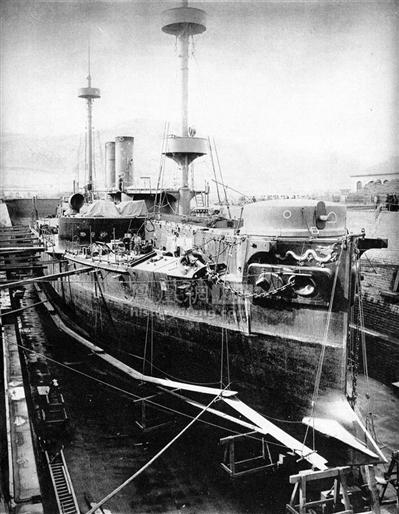The War of Jiawu awakening Chinese from years of sleep

Vessal Dingyuan, one of the major battleships of Beiyang Fleet established in late Qing Dynasty, was captured by Japanese navy as the fleet was defeated in the War of Jiawu.
On July 25, 120 years ago, the Japanese army attacked the Qing forces stationed at Pungdo in Korea, igniting the War of Jiawu. An important battlefield of the war, Liugong Island, a small island on the Yellow Sea, was the site of a great tragedy for the Chinese people — the destruction of the Beiyang Fleet, China’s first modern navy.
Over a century ago, young officers of the Beiyang Fleet, such as Liu Buchan and Lin Taizeng, were trained in Great Britain. When they took charge of battleships made in the West, like the Dingyuan, Zhenyuan and Chaoyong, they were eager to build a modern Chinese navy and learn from the advanced technologies of the West in order to resist the invasion of the Western powers.
Qi Qizhang, the late expert on the War of Jiawu, estimated that by the time it was established at Liugong Island in 1888, the Beiyang Fleet had nearly 50 battleships. In 1889, the U.S. Secretary of the Navy Benjamin Franklin Tracy ranked the Chinese navy as the ninth-strongest in the world, outranking the navies of America and the Japan.
However, the fleet, established by Li Hongzhang and thought to be the unbeatable guardian of the Bohai Sea, was completely defeated in the War of Jiawu only seven years after its establishment.
Long before we set foot on the island, we could already see in the distance the Monument for the Loyal Souls backed by the green vegetation on the island, thrusting into the sky like a sword. Today, people can still see 17 relics of the war on the island. As the boat landed, we seemed to have heard a warning bell from history at the sight of the relics of war.
Cong Huazi, deputy curator of the Museum of Sino-Japanese War on the island, told us that with six artillery batteries on it, the island was an important navy base at Weihaiwei. From the vantage point of the island, the Qidingshan Battery could support other batteries on the island as well as batteries along the shore of Weihaiwei, forming a crossfire system that could prevent the enemy from getting close to the shore.
However, it failed to defend against attacks from the Japanese land and naval forces. The Beiyang Fleet eventually failed to turn the tide of the war and consequently The Treaty of Shimonoseki was signed in 1895.
An old man told us a story of a hero named Zhou Jiaen during the war. “When the Japanese were attacking the Motianling Barbette, this tough man Zhou Jiaen commanded his soldiers to combat the enemy several times. At that time, people saw the national flag of Qing fall three times, but it was re-raised each time.” Stories of such patriotic heroes are still popular among local residents today.
A great number of historical documents and pictures can be seen at the Museum of Sino-Japanese War, where people can get connected to the war directly. At the exit of the museum, we saw the notes left by one visitor, which read “Remember history and keep alert, defend our nation and our maritime rights.”
After the War of Jiawu, China faced a crisis as it was carved up by imperial powers, while it was also a turning point for the nation. Liang Qichao once noted, “The awakening of the Chinese people after thousand years of sleep began with the War of Jiawu.”
Zhang Haipeng, a member of the Academic Division of the CASS, observed that after the war, “saving the nation” became the priority for the patriotic. Revolutionaries and reformists appeared everywhere, driving changes in China.
“The failure was first of all due to the corruption of the Qing government’s social and military system. What is more, it was largely due to the government’s ignorance of maritime rights,” said Qi Junjie, former curator of the Museum of Sino-Japanese War. “We need to strengthen our awareness of maritime rights”, he emphasized.
Early in the morning the next day, as we took a ship departing from Liugong Island, we saw a cruiser of the Chinese navy at the port, where sailors were practicing on the deck with a high morale.
The Chinese version appeared in Chinese Social Sciences Today, No. 624, July 25, 2014
Edited and translated by Bai Le
The Chinese link:
